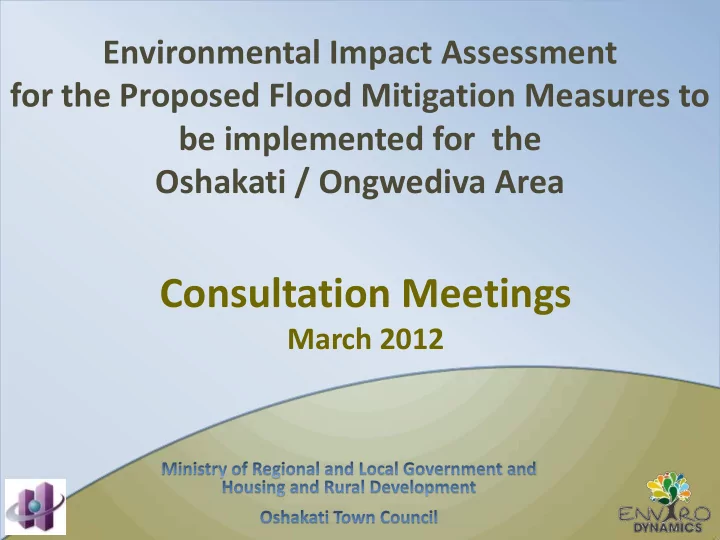

Environmental Impact Assessment for the Proposed Flood Mitigation Measures to be implemented for the Oshakati / Ongwediva Area Consultation Meetings March 2012
Agenda • Introduction and welcome (10) • The EIA process (20) • Project overview (30) • Technical Clarification (10) • Issues Identified (10) • Consultation (40) • Wrap up (11:30)
Project Scope Proposed Flood Mitigation Measures to be implemented for the Oshakati / Ongwediva Area consisting of: • Cleaning and deepening of the Okatana River in Oshakati • Construction of a dyke system to the north and west of the town of Oshakati
Locality Map
Introduction The Proponent Team Name Organisation Role Martin Shikongo MRLGHRD Project Manager Joshua Kaitungwa PMS Consultant Gunter Leicher Knight Piesold Consultant Ronnie van Looveren BAR Consultant Jan Wynants BAR Consultant Martha Amupolo BAR Consultant
Introduction The EIA Team Name Organisation Role Norman van Zyl Enviro Dynamics Impact Assessment Stephanie van Zyl Enviro Dynamics Impact Assessment Ernst Simon Urban Dynamics Socio-economic Chris Muir WCE Hydrology Carla Saayman Enviro Dynamics Public consultation
EIA Process • Environmental Management Act, 2007 ( 7 of 2007) • The Regulations now promulgated. • Therefore we will use this as the framework for this project. • There are other regulations and Acts that integrates into the EIA process. • Water Management Act • Forestry Act
EIA combines public values and technical facts Technical Environmental Analysis EIA Facts Decision Values Public Consultation
EIA Process Scoping Key issues Scope of EIA Environmental Assessment Specialists Analyse Impacts Mitigation Measures Environmental Appea l ? Decision Management Plan Implementation
YOUR ROLE Interaction with the client and its CONSULTATION technical team FEEDBACK SCOPING ASSESSMENT REPORTING DATA GATHERING
Roles at this meeting Proponent: Provide project information, • including aspects which interact with the environment. EIA consultants: Explain EIA process, facilitate • open and sincere discussions, accurately record input. Audience: Understanding project, • provide input to be investigated.
House Rules • Allow for clarification after project overview • Allow for comment after discussing issues identified • Speak through the chair of the meeting • State name clearly before asking questions • Speak slowly and clearly • Respect other views on the project
Project overview Technical Team BAR KNIGHT PIESOLD
Clarification questions Clarify the project overview Speak through the chair of the meeting State name clearly before asking questions
Issues identified so far • Benefits of the project • The benefit of the reduction in flooding in Oshakati which has a huge negative impact on people and their livelihoods as well as on the ability of the Town Council to provide services to its constituents. • The benefit of being able to lay dry large areas, which are currently subjected to flooding, allows for the much more logical and cost effective development of the Urban Area of Oshakati.
Issues identified so far • Land use and people • The footprint of the dyke and the channel next to it will result in the need to relocate homesteads and fields which are in the way. • The land use of the affected area is mostly subsistence agriculture. Loss of land means loss of livelihood of the affected households. • The dyke could potentially cause, through a backwater effect, flooding of homesteads and fields located to the north and west of the dyke and channel. • Fruit bearing trees and other usefull vegetation may be lost to accommodate the footprint of the dyke and channels.
Issues identified so far • Effects on the river system • The water in the Oshanas may have a high silt load. This could result in the channels silting up and thereby increase flooding upstream and to the west of the dyke. • The ephemeral river system through the town may be a pollution hazard if not maintained. • The natural abilities of the river system to cleanse itself is removed if normal flow of water is reduced or interrupted • The concrete lining will affect the ecosystem functioning in the area.
Issues identified so far • Effects on the downstream river system • Depending on the extent of diversion of water, it may cause some areas to dry up and may influence the availability of surface and groundwater in certain areas which may bring about changes to the local ecology and the plant and animals community so supported. • If the water retention reservoir is constructed, it will reduce the downstream flow, which may affect the Etosha ecosystem and the tourism it attracts.
Consultation • State name clearly before commenting • Cards- write down issues • Be specific on your issue • One issue per card • Beware of generalization
Consultation • Free and open discussion on: • What worries you about the project • What do you find positive about the project • Any other comments or issues
Wrap Up • Did you sign the Attendance Register? • Comments to reach us by Contact: Carla Saayman carla@envirod.com Tel: (061) 223 336 Fax: (061) 307437
Recommend
More recommend